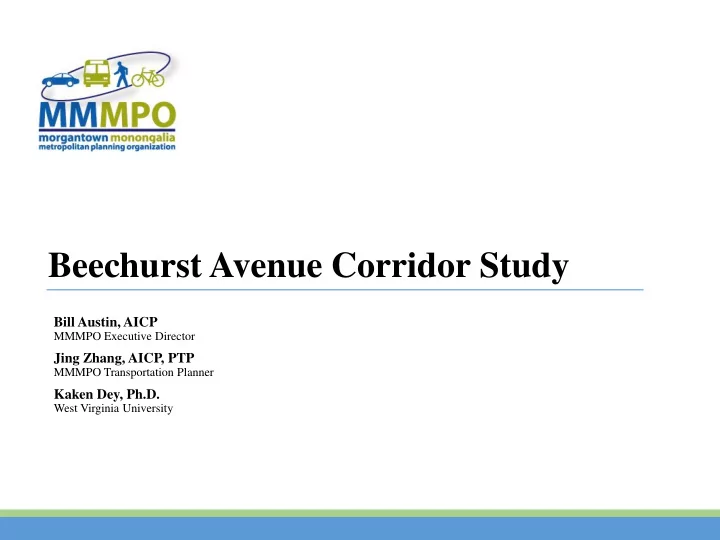

Beechurst Avenue Corridor Study Bill Austin, AICP MMMPO Executive Director Jing Zhang, AICP, PTP MMMPO Transportation Planner Kaken Dey, Ph.D. West Virginia University
Project Introduction Existing Conditions and Proposed Alternatives VISSIM Model
Project Site. Transportation Network
WV DOH Beechurst Ave Study (2003)
Falling Run and Beechurst Ave Connection Study
Project Site
Project Site. Land Use
Project Site. Traffic Volume (AADT) 100 22,788 80 60 40 7,265 20 0 EB WB 20,361 400 19,281 23,150 300 200 22,810 100 0 SB NB
Project Site. Crash
Project Site. Pedestrian & Transit
Project Site. Land Use
Project Site. Past Planning Effort
Project Site. Past Planning Effort
8 th Street Existing Lane Configuration Transition Campus Dr Hough St Fayette St Walnut St Hough St Campus Dr Pleasant St Fayette St Foundry St Walnut St Pleasant St Foundry St Hurley St
Project Site. Existing Operation 1 2 1 3 4 2 3 4
Project Site. Existing Lane Configuration
Key Issue Corridor Capacity • Northbound through movement • Intersection configuration Multi-model Transport • Trail connection • Transit and pedestrian facility • PRT Station Transfer Land Use • Infill/Redevelopment • Neighborhood Development • University Development
Alternative Development • Segment Alternatives • Intersection Alternatives • Scenarios
Alternative Development, Segment
Alternative Development, Segment
Alternative Development, Intersection
Alternative Development, Intersection
Alternative Development, Intersection
Alternative Development, Intersection
Alternative Development, Intersection
Alternative Development, Scenarios Scenario I, Minimum Impact Scenario II, Minimum Impact + Intersection Improvements Scenario III, ROW Impact + Intersection Improvements Scenario IV, ROW Impact + Significant Intersection Improvements Scenario V, 4 lanes-3 lanes Mix + Intersection Improvements
Scenario I, Minimum Impact 6 th St 8 th St 3 rd St 1 1 Campus Dr 1 Fayette St No left-turn when Pleasant St opposing traffic is on green Foundry St
Scenario II, Minimum Impact + Intersection Improvements 6 th St 8 th St th St 3 rd St 1 1 Campus Dr 1 Fayette St Pleasant St Foundry St
Scenario III, ROW Impact + Intersection Improvements 6 th St 8 th St 3 rd St 1 1 Campus Dr 1 2 Fayette St 2 Pleasant St Foundry St
Scenario IV, ROW Impact + Significant Intersection Improvements 6 th St 8 th St 3 rd St 1 1 Campus Dr 1 2 Fayette St 2 Pleasant St Foundry St
Scenario V, 4 lanes-3 lanes mix + Intersection Improvements 6 th St 1 8 th St 3 rd St 1 2 Campus Dr 1 2 3 Fayette St Pleasant St Foundry St 3
What is VISSIM? VISSIM is a microscopic, time step, and behavior based traffic simulation computer program VISSIM models urban traffic and public transit operations VISSIM can analyze traffic ( cars, trucks, pedestrians ) and transit ( buses, trains, trams ) operations under constraints such as lane configuration, traffic composition, traffic signals, transit stops, etc.
VIS ISSIM Mic icrosimula lation Appli lications • Junction Geometry • Signal control • Traffic-actuated signal control • Multimodality • Multimodal Systems • Motorway Traffic • Active Traffic Management • Public Transport • Distribution-based dwell time • Public transport priority • Emissions Modelling • Mesoscopic and Hybrid Simulation • Virtual testing of autonomous vehicles
Beechurst Ave Stu tudy- Existing & Future Scenarios Existing Condition • Morning Peak network development • Geometric data- used Google Maps and field data • Volume data- MMMPO provided • Speed, travel time data, signal timing- MMMPO provided • Evening Peak Future Scenarios • Scenarios- (1) to (6) 10/24/2017 34
Sim imula lation Procedure 1) Model Development 2) Initial System Evaluation 3) Model Calibration • System Calibration • Operational Calibration 4) Model Evaluation 5) Model Validation
Morning Peak Sim imulation Run
Comparison between Exis isting scenario & & Proposed Improvement scenarios Performance Measurers • Corridor Travel time • Corridor Delay • Queue length at intersection approaches
Questions? Thank You!
Recommend
More recommend